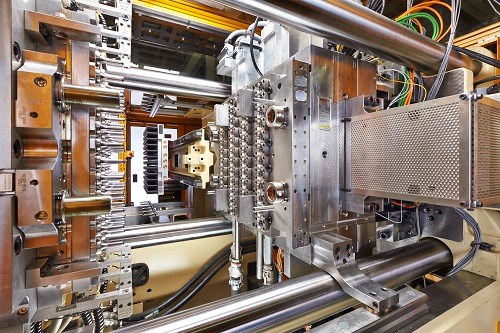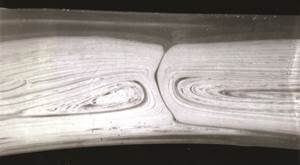More Details on Husky’s Barrier Coinjection Debut
New challenger promises big savings through more uniform barrier-resin distribution.

The initial announcement by Husky Injection Molding Systems, Bolton, Ont., that it would be discussing its new barrier coinjection solution for PET preforms at NPE2015 next month in Orlando was short on details. However, a conversation with Nicolas Rivollet, director of business development, clarified Husky’s goals and achievements in this project.
As Rivollet put it, Husky’s intent is “to change the business case for multilayer preforms” as a solution to PET barrier container needs for foods and beverages. “There’s nothing revolutionary in the technology, but our level of performance is unique.” According to Rivollet, the “make or break” challenge is to “distribute minute amounts of barrier material—in some cases, as little as 0.25 g or 2%—very uniformly. We’re talking about only 20 to 25 pellets of barrier material in a 15-20 g preform.” The barrier could be EVOH or nylon sandwiched between inner and outer layers of PET; or, in the case of milk bottles, a black HDPE layer could provide light barrier between two white HDPE layers.
Husky has worked in the past with Kortec (recently acquired by Milacron of Cincinnati), supplying the injection machine for Kortec’s turnkey barrier coinjection systems. Now Husky is proceeding on its own to offer a module for its HyPET HPP5 system, which includes a multi-channel coinjection nozzle, small side-mounted secondary injection unit, and the mold with hot-runner system. Husky is starting out with 48 cavities and will later add 72 and 96 cavities.
Rivollet said Husky saw “room for improvement in the ability to control the total amount and distribution of expensive barrier material both between cavities and within each individual preform. One typically targets 5% barrier content by weight, but when we measured the actual result, we found it ranged between 4% and 6.5% of total preform weight.” He said that 5 ± 1.5% variation “is very common and a pretty wide bandwidth.” He further noted that with current technology “You can reduce that somewhat with highly trained operators and frequent stops and tweaks.”
Husky’s new module built on the HyPET HPP5 platform, Rivollet claims, can reduce cavity-to-cavity and shot-to-shot variation in barrier content to ± 0.5%, which can lead to cost savings of as much as 50% in barrier material. “We can achieve the same average barrier content, but with lower quality risk,” he said. “The real question is what is the minimum barrier content that you need. If it’s 4%, then today, with a low-capability system, you would have to set your average at 6.3% to ensure no more than 100 ppm of preforms would go below target. With our high-capability technology, you could set your target at 4.5% with a narrower tolerance band. At $9000/ton for barrier resin, that has a big impact on total cost.”
The melt delivery system is the key to this achievement, Rivollet explains. It includes Husky’s valve-gate hot-runner system with new advances that achieve 50% tighter balance between cavities than Husky’s current conventional hot runner, which the firm says is already “best in class.” Said Rivollet, “We utilized a different concept that reduces the number of splits in the melt and special melt channels that reduce temperature differences between cavities. The result is better thermal balance and lower pressure drop.” And unlike other systems, he added, all the nozzle tips are accessible from the front for easier maintenance.
Although data is still being collected from R&D studies, Rivollet said preliminary results indicate that Husky’s barrier module also achieves more uniform distribution of barrier resin within each preform. Husky is working on measuring devices that can see through the thickness of the preform for non-destructive measurement of the barrier layer. “Our nozzle design helps,” he said, “by providing better control of the leading and trailing edges of the barrier-layer melt during injection.”
While officially introducing its barrier concept at NPE, it will not be running a demonstration at the show. However, the barrier module is based on Husky’s latest-generation HyPET HPP5 system for PET preforms, which will be running at the booth. Rivollet says the cycle time and machine availability of the barrier module are exactly the same as for the HPP5 with monolayer preforms.
Related Content
What to Do About Weak Weld Lines
Weld or knit lines are perhaps the most common and difficult injection molding defect to eliminate.
Read MoreHow to Reduce Sinks in Injection Molding
Modifications to the common core pin can be a simple solution, but don’t expect all resins to behave the same. Gas assist is also worth a try.
Read MoreHow to Set Barrel Zone Temps in Injection Molding
Start by picking a target melt temperature, and double-check data sheets for the resin supplier’s recommendations. Now for the rest...
Read MoreA Simpler Way to Calculate Shot Size vs. Barrel Capacity
Let’s take another look at this seemingly dull but oh-so-crucial topic.
Read MoreRead Next
How Polymer Melts in Single-Screw Extruders
Understanding how polymer melts in a single-screw extruder could help you optimize your screw design to eliminate defect-causing solid polymer fragments.
Read MoreLead the Conversation, Change the Conversation
Coverage of single-use plastics can be both misleading and demoralizing. Here are 10 tips for changing the perception of the plastics industry at your company and in your community.
Read More
























